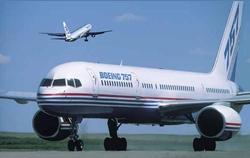Sun, May 23, 2010
Flight To Los Angeles Diverted To Dulles Airport Near
Washington, DC
 The NTSB has released a factual report in its continuing
investigation of a fire aboard a Boeing 757 that diverted to Dulles
Airport (IAD) enroute to the Los Angeles International airport
(LAX) from New York's John F. Kennedy International airport
(JFK).
The NTSB has released a factual report in its continuing
investigation of a fire aboard a Boeing 757 that diverted to Dulles
Airport (IAD) enroute to the Los Angeles International airport
(LAX) from New York's John F. Kennedy International airport
(JFK).
The factual report reads:
"On Sunday, May 16, 2010, about 2117 EDT the pilots on United
Airlines flight 27, a Boeing 757, N510UA, noted a strong acrid
smell and observed smoke from the Captain's lower front windshield.
The incident occurred about 30 minutes into the flight while the
aircraft was level at 36,000 feet MSL. On board the aircraft were 7
crew members and 105 passengers.
"The Captain and First Officer reported that they donned their
oxygen masks and smoke goggles immediately after observing the
smoke and fire. The Captain then gave control of the airplane to
the First Officer and discharged a halon fire extinguisher. The
smoke and fire dissipated but then re-ignited. The Captain obtained
a second bottle from the Purser. The fire remained extinguished
after this second bottle was discharged. At approximately 500 feet
MSL on final approach to Runway19L at IAD, the Captain's windshield
cracked. The landing was uneventful. The airplane cleared
the runway, after which ARFF (Aircraft Rescue Firefighting) entered
the aircraft to check for residual heat and fire. None was found
and the airplane was towed to the gate for deplaning. There were no
evacuation and no injuries to the flight crew or passengers.

File Photo
"Preliminary examination of the cockpit area revealed that the
inner pane of the Captain's windshield had cracked. One of the five
terminal blocks attached to the inside of the lower left windshield
was consumed by fire and the portion of the wire harness associated
with this terminal block was
significantly damaged by fire. There was significant sooting and
paint peeling to the left hand side of the windshield air frame
support.
"The Captain's windshield was moved and will be examined by
Board investigators at the manufacturer."
Two previous windshield fire events on B757-200 aircraft
prompted the NTSB to issue Safety
Recommendation A-07-50. The NTSB says investigators will look
closely at the recovered hardware to determine if this latest event
is related.
More News
Light Gun A handheld directional light signaling device which emits a brilliant narrow beam of white, green, or red light as selected by the tower controller. The color and type of>[...]
"The journey to this achievement started nearly a decade ago when a freshly commissioned Gentry, driven by a fascination with new technologies and a desire to contribute significan>[...]
Aero Linx: JAARS, Inc. For decades now, we’ve landed planes on narrow rivers and towering mountains. We’ve outfitted boats and vehicles to reach villages that rarely se>[...]
"Our driven and innovative team of military and civilian Airmen delivers combat power daily, ensuring our nation is ready today and tomorrow." Source: General Duke Richardson, AFMC>[...]
Aircraft Conflict Predicted conflict, within EDST of two aircraft, or between aircraft and airspace. A Red alert is used for conflicts when the predicted minimum separation is 5 na>[...]
 ANN's Daily Aero-Term (04.20.24): Light Gun
ANN's Daily Aero-Term (04.20.24): Light Gun Aero-News: Quote of the Day (04.20.24)
Aero-News: Quote of the Day (04.20.24) ANN's Daily Aero-Linx (04.21.24)
ANN's Daily Aero-Linx (04.21.24) Aero-News: Quote of the Day (04.21.24)
Aero-News: Quote of the Day (04.21.24) ANN's Daily Aero-Term (04.21.24): Aircraft Conflict
ANN's Daily Aero-Term (04.21.24): Aircraft Conflict




